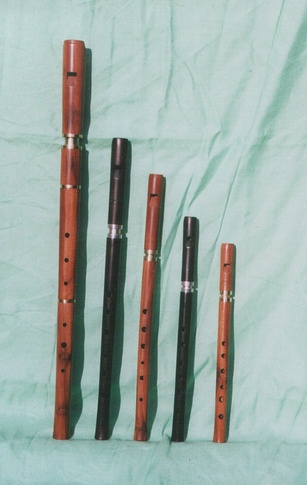NEW
VIDEO REVIEWS BY
PHIL HARDY
Take a look at the rest of Phil's site while you are there.
&
TONY HINNIGAN

Key of D
Price £ 260.00
Key of C
Price £ 300.00
Key of B flat
Price £ 330:00
Key of G
Price £ 390.00
LOW WHISTLES
Key of D
Price £ 660.00
ALL PRICES NOW INCLUDE INSURED POST AND PACKING
Following many stories of people whose low whistles
are difficult to play for reasons of very high air consumption,
over large finger holes too far apart, or an inability to play
above the fourth note in the second register, I was determined to
make my low whistles free of these problems and ensure that they had
the same quality of tone and intonation as the other whistles that
I make.
Many of you will know that this has taken several years but at last
I am satisfied with the results and offer an instrument worthy of
the title.

My low whistles use a good range of pressure increasing steadily
through the range without a huge increase in air consumption which
allows you to employ as much expression as you want.
Flexibility throughout
the range of 2 octaves and a tuning slide with ample adjustment
allows you to keep up with the wildest of sessions. The dense
timbers used to make these instruments mean that you have to warm
them up well but once warm they stay that way. Each of my
low whistles is played in by me during voicing to eliminate any
problems from moisture distorting the block, the special shape of
which allows it to 'work' in the windway with no undue effect on
performance.
I hope that you will find the time to explore the versatility of
these instruments when you visit me either on my exhibition stands
around Europe or at my home. I look forward to seeing you.
TIMBER
We use timbers which are not endangered and which come from managed
sources, ensuring a sustainable supply for the future.
I normally work in the following woods:
African blackwood, boxwood, mopane, olive and fruit woods
WHISTLE HISTORY
For centuries Man has been making simple woodwind instruments which
fit the description of whistle, these have been made of clay and
bone, more recently the tin whistle has appeared on the scene, and
throughout
history there have been wooden whistles. All of these penny whistles
were diatonic (made to play in one key)and used by ordinary folk
to play traditional music. There are surviving tin whistles, often of
brass with lead blocks which, I believe, were used to play military
music. I recently had the pleasure of examining a penny whistle found
in the bed of an English river not far from where I live, it is made
of wood, decorated all over with a diamond pattern, has the fipple
on the underside and no beak. Some French penny whistles even have a
separate mouthpiece to enable playing sideways to look like a marching
fife. There seems to be no limit to the variety of tin whistles or
penny whistles which have been produced over the years. I am pleased
to have added my own tuneable whistles to the list.
Phil and Claire Bleazey
At The Old Furness Street Stables
LANCASTER
LA1 5QZ
Tel:- 0044 (0)1524 849085
Last Updated November 2022















